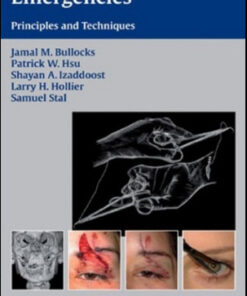PLASTIC & RECONSTRUCTIVE SURGERY
Principles and Techniques in Oncoplastic Breast Cancer Surgery
PLASTIC & RECONSTRUCTIVE SURGERY
PLASTIC & RECONSTRUCTIVE SURGERY
PLASTIC & RECONSTRUCTIVE SURGERY
Plastic Surgery Exam Questions and Answers: A Guide to the Plastic Surgery exit exam
PLASTIC & RECONSTRUCTIVE SURGERY
PLASTIC & RECONSTRUCTIVE SURGERY
PLASTIC & RECONSTRUCTIVE SURGERY
PLASTIC & RECONSTRUCTIVE SURGERY
PLASTIC & RECONSTRUCTIVE SURGERY
Techniques of Botulinum Toxin Injections in the Head and Neck
PLASTIC & RECONSTRUCTIVE SURGERY
Plastic Reconstructive and Aesthetic Surgery: The Essentials
PLASTIC & RECONSTRUCTIVE SURGERY
PLASTIC & RECONSTRUCTIVE SURGERY
PLASTIC & RECONSTRUCTIVE SURGERY
PLASTIC & RECONSTRUCTIVE SURGERY
PLASTIC & RECONSTRUCTIVE SURGERY
Orthognathic Surgery: Principles and Practice – 2 Volume Set
PLASTIC & RECONSTRUCTIVE SURGERY
PLASTIC & RECONSTRUCTIVE SURGERY
PLASTIC & RECONSTRUCTIVE SURGERY
PLASTIC & RECONSTRUCTIVE SURGERY
Chirurgie plastique réparatrice de la face et du cou Volume 1
PLASTIC & RECONSTRUCTIVE SURGERY
PLASTIC & RECONSTRUCTIVE SURGERY
PLASTIC & RECONSTRUCTIVE SURGERY
Atlas of Breast Surgical Techniques: A Volume in the Surgical Techniques Atlas Series
PLASTIC & RECONSTRUCTIVE SURGERY
PLASTIC & RECONSTRUCTIVE SURGERY
Plastic and Reconstructive Surgery Board Review: Pearls of Wisdom, 2nd Edition
PLASTIC & RECONSTRUCTIVE SURGERY
PLASTIC & RECONSTRUCTIVE SURGERY
Cosmetic Injection Techniques: A Text and Video Guide to Neurotoxins and Fillers
PLASTIC & RECONSTRUCTIVE SURGERY
PLASTIC & RECONSTRUCTIVE SURGERY
Plastic and Reconstructive Surgery of the Breast, 2nd Edition
PLASTIC & RECONSTRUCTIVE SURGERY
PLASTIC & RECONSTRUCTIVE SURGERY
Introduction
Are you considering plastic and reconstructive surgery? If so, it’s important to understand the potential benefits of this type of procedure. This guide will provide an overview of the advantages of plastic and reconstructive surgery, helping you make an informed decision about whether or not it is right for you. From improved self-confidence to enhanced physical appearance, there are many potential benefits that can be gained from plastic and reconstructive surgery. We’ll discuss these in detail, as well as the risks associated with the procedure. By the end of this guide, you should have a better understanding of the potential benefits and drawbacks of plastic and reconstructive surgery.
Overview of Plastic & Reconstructive Surgery: Types, Benefits, and Risks
Plastic and reconstructive surgery is a medical specialty that focuses on the restoration, reconstruction, or alteration of the human body. It can be used to improve a person’s appearance, correct deformities, or repair damage caused by trauma or disease. Plastic and reconstructive surgery can also be used to restore function in areas of the body affected by injury or illness.
Types of Plastic & Reconstructive Surgery
There are many different types of plastic and reconstructive surgery procedures available. Some of the most common include:
• Facial reconstruction: This type of surgery is used to correct facial deformities or to restore facial features that have been damaged due to trauma or disease.
• Breast reconstruction: This type of surgery is used to reconstruct the breasts after mastectomy or other breast-related surgeries.
• Hand surgery: This type of surgery is used to repair injuries or defects in the hands, such as carpal tunnel syndrome or nerve damage.
• Skin grafting: This type of surgery is used to replace damaged or missing skin with healthy skin from another part of the body.
• Tissue expansion: This type of surgery is used to stretch the skin so that it can be used to cover larger areas of the body.
Benefits of Plastic & Reconstructive Surgery
Plastic and reconstructive surgery can provide many benefits, including:
• Improved self-esteem: Many people who undergo plastic and reconstructive surgery report feeling more confident and comfortable in their own skin.
• Improved physical health: Plastic and reconstructive surgery can help to improve physical health by correcting deformities or restoring function to areas of the body affected by injury or illness.
• Improved quality of life: Plastic and reconstructive surgery can help to improve a person’s quality of life by allowing them to participate in activities they may not have been able to do before.
Risks of Plastic & Reconstructive Surgery
As with any medical procedure, there are risks associated with plastic and reconstructive surgery. These risks include:
• Infection: Infection is a risk with any surgical procedure.
• Bleeding: Bleeding is a risk with any surgical procedure.
• Scarring: Scarring is a risk with any surgical procedure.
• Nerve damage: Nerve damage is a risk with any surgical procedure.
• Anesthesia complications: Anesthesia complications are a risk with any surgical procedure.
• Blood clots: Blood clots are a risk with any surgical procedure.
• Allergic reactions: Allergic reactions are a risk with any surgical procedure.
• Unsatisfactory results: Unsatisfactory results are a risk with any surgical procedure.
It is important to discuss all potential risks with your doctor before undergoing any type of plastic and reconstructive surgery.
Exploring the Different Types of Plastic & Reconstructive Surgery Procedures
Plastic and reconstructive surgery is a field of medicine that focuses on restoring or improving the appearance and function of the body. It can be used to correct physical deformities, repair damage caused by trauma or disease, and improve the overall aesthetic of the body. Plastic and reconstructive surgery procedures are highly specialized and require extensive training and experience.
The most common type of plastic and reconstructive surgery is cosmetic surgery. This type of surgery is designed to enhance the appearance of the body, usually through the use of implants, fat grafting, and other techniques. Common cosmetic procedures include breast augmentation, liposuction, rhinoplasty, facelifts, and tummy tucks. These procedures can help to improve the shape and size of certain areas of the body, as well as reduce wrinkles and other signs of aging.
Reconstructive surgery is another type of plastic and reconstructive surgery. This type of surgery is used to restore the form and function of the body after an injury or illness. Reconstructive surgery can be used to repair damaged tissue, replace missing parts, and restore normal movement and sensation. Common reconstructive procedures include skin grafts, scar revision, and hand surgery.
Another type of plastic and reconstructive surgery is microsurgery. This type of surgery involves the use of very small instruments and techniques to repair or reconstruct tissue. Microsurgery is often used to repair nerve damage, reattach severed limbs, and reconstruct facial features.
Finally, there is also reconstructive burn surgery. This type of surgery is used to treat severe burns and other injuries that have caused significant damage to the skin. Reconstructive burn surgery can involve skin grafts, tissue expansion, and other techniques to restore the appearance and function of the affected area.
No matter what type of plastic and reconstructive surgery you may need, it is important to find a qualified and experienced surgeon who can provide the best possible care. A good surgeon will take the time to understand your needs and goals and develop a treatment plan that is tailored to your individual needs.
Preparing for Plastic & Reconstructive Surgery: What to Expect
Recovering from Plastic & Reconstructive Surgery: Tips for a Smooth Recovery
Recovering from plastic and reconstructive surgery can be a difficult process, but with the right preparation and care, you can ensure a smooth recovery. Here are some tips to help you get through the recovery period:
1. Follow your doctor’s instructions: It is important to follow all of your doctor’s instructions for post-operative care. This includes taking any prescribed medications, attending follow-up appointments, and following any other instructions given by your doctor.
2. Get plenty of rest: Rest is essential for a successful recovery. Make sure to get plenty of sleep and take breaks throughout the day. Avoid strenuous activities and heavy lifting during this time.
3. Eat healthy: Eating a balanced diet is important for healing and recovery. Make sure to eat plenty of fruits, vegetables, and lean proteins. Avoid processed foods and sugary snacks.
4. Stay hydrated: Drinking plenty of water is essential for a successful recovery. Staying hydrated helps to flush out toxins and keep your body functioning properly.
5. Take care of your incision site: Make sure to keep the incision site clean and dry. Follow your doctor’s instructions for changing dressings and cleaning the area.
6. Avoid smoking: Smoking can slow down the healing process and increase the risk of complications. If you smoke, it is important to quit before and after surgery.
7. Manage pain: Pain is a normal part of the recovery process. Make sure to take any prescribed pain medications as directed. You can also use over-the-counter medications such as ibuprofen or acetaminophen to manage pain.
8. Ask for help: Don’t be afraid to ask for help if you need it. Friends and family can help with tasks such as grocery shopping, cooking, and cleaning.
Following these tips can help ensure a smooth recovery from plastic and reconstructive surgery. Remember to listen to your body and contact your doctor if you experience any unusual symptoms.
Financing Options for Plastic & Reconstructive Surgery: Insurance Coverage and Other Alternatives
Plastic and reconstructive surgery can be a costly endeavor, but there are several financing options available to help make the process more affordable. Insurance coverage is one of the most common ways to pay for plastic and reconstructive surgery, as many insurance plans cover some or all of the costs associated with these procedures. Other alternatives include medical credit cards, loans from banks or other financial institutions, and crowdfunding.
Insurance Coverage
Many health insurance plans cover some or all of the costs associated with plastic and reconstructive surgery. The extent of coverage depends on the type of procedure being performed and the individual’s insurance plan. Generally, insurance companies will cover procedures that are medically necessary, such as breast reconstruction after a mastectomy or facial reconstruction after an accident. Cosmetic procedures, such as rhinoplasty or liposuction, are typically not covered by insurance. It is important to check with your insurance provider to determine what types of procedures are covered and what out-of-pocket expenses you may be responsible for.
Medical Credit Cards
Medical credit cards are another option for financing plastic and reconstructive surgery. These cards are specifically designed to cover medical expenses and offer low interest rates and flexible payment plans. They can be used to cover the entire cost of the procedure or just a portion of it. Medical credit cards are accepted at most plastic surgery practices and can be a great way to spread out the cost of the procedure over time.
Loans from Banks or Other Financial Institutions
Banks and other financial institutions offer loans specifically designed to cover the cost of plastic and reconstructive surgery. These loans typically have lower interest rates than medical credit cards and can be used to cover the entire cost of the procedure. However, they usually require a good credit score and may take longer to process than medical credit cards.
Crowdfunding
Crowdfunding is a relatively new option for financing plastic and reconstructive surgery. This involves setting up an online fundraising campaign to raise money for the procedure. Donors can contribute any amount they wish and the funds are collected through a secure platform. Crowdfunding campaigns can be a great way to cover the cost of plastic and reconstructive surgery, especially if the procedure is not covered by insurance.
No matter which financing option you choose, it is important to do your research and understand the terms and conditions of each option before committing to anything. Plastic and reconstructive surgery can be expensive, but with the right financing option, it can be made more affordable.
Conclusion
Plastic and reconstructive surgery can be a great way to improve your appearance, health, and quality of life. It is important to understand the risks and benefits associated with any procedure before making a decision. With the help of a qualified plastic surgeon, you can make an informed decision about whether or not plastic and reconstructive surgery is right for you. By understanding the potential benefits and risks, you can make an educated decision that will help you achieve the results you desire.






























